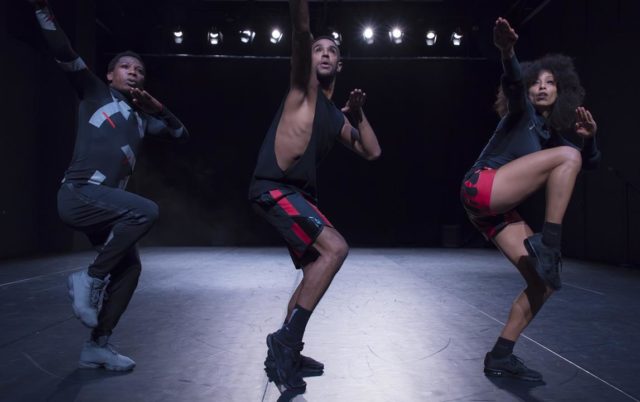
It took me about 15 minutes to notice that the performers in Ligia Lewis’s “minor matter” were wearing black contacts that obscured the white of their eyes. That’s probably because for the duration of the piece, I was preoccupied by the worry that performers Jonathan Gonzalez, Ligia Lewis, and Hector Thami Manekehla might accidentally break a partner’s vertebrate. “minor matter” is approximately 65 minutes of these dancers slamming each other on the floor, climbing on top of one another and basically beating the shit out of each other. I loved it.
The performance is part of the American Realness Festival at the Abrons Art Center (on through Tuesday January 10), and I recommend everyone see it—but for small children likely to try to imitate the performers. Past the pure athleticism required to do even half the moves I saw, the show’s forceful exhalation of the body and life itself is enough to make nearly every viewer happy.
The show opens in a darkened space, gradually lit enough to reveal and empty stage but for three performers lying on the floor. Each wear black and red shorts and tops that evoke medieval wear and many of their early gestures point to this as well. Jonathan Gonzalez takes the pose of a old lion statue with its tongue out. Lewis and Manekehla follow suit.
Aesthetics drive the piece, from the art historical references mentioned above to the continual reshaping and testing of the body. The action starts almost immediately. We weren’t more than 10 minutes in and Thami Manekehla had stood on Lewis’s back as she crawled across the stage. Not too much later, Lewis walked over both Thami Manekehla and Gonzalez as they laid on the floor. Audible gasps from the audience were heard.
While these kinds of moves take on a spectacular feel, “minor matter” is largely defined by it’s minimal aesthetics—sparse spoken word and dancing that takes place across a prop-less stage. “What am I going to be?” Gonzalez begins, in one of the few soliloquies in the piece. “I’m gonna be an astronaut.” he continues. “It takes work to be an astronaut.” Meanwhile, Lewis and Manekehla fling each other’s bodies around behind him.
As far as I can tell, there’s no literal interpretation to a lot of the text that gets spoken, though I suppose some of it could hue back to identity themes described in the press release. For example, when Gonzalez said he did not want to talk about politics, the way he modulated his voice and body to mimic and reject noisy annoying talk, could relate to Lewis’s interest in the black experience and minorities working together. She calls this “minoritarian politics”.
Then again, it’s possible she never intended the text to be read so literally and my feeling is that the piece does better when specific reads like that aren’t imposed on it. “minor matter” doesn’t need a narrative to hold together what is best expressed through dance.
And in this case, the clearest message I took home from the piece was that there was no better means of visualizing life and vitality than through the body. At one point, maybe a third of the way through the performance, Gonzalez rolls his body and chest as he hunches over before erupting into choreographed clapping with the other dancers. The only note I have from segment is “moves look like life”. It was the shortest way I could think to describe what I was seeing. (It’s hard to take notes in the dark.)
From that point on, life was all I saw. The dancers threw themselves into knots, hoisted each other up against the walls, and even downed pants for a bit of dry fucking. It was invigorating just to watch. By the end of it all, Lewis had blood dripping from her knee, and the three were entirely out of breath. It felt like a celebration.


Comments on this entry are closed.